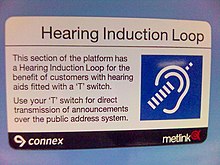
Audio induction loop systems, also called audio-frequency induction loops (AFILs) or hearing loops,[1] are an assistive listening technology for individuals with reduced ranges of hearing.[2]
A hearing loop consists of one or more physical loops of cable which are placed around a designated area, usually a room or a building. The cable generates an electromagnetic field throughout the looped space which can be picked up by a telecoil-equipped hearing aid, a cochlear implant (CI) processor, or a specialized hand-held hearing loop receiver for individuals without telecoil-compatible hearing aids.
The loops carry baseband audio-frequency currents; no carrier signal is used. The benefit is that it allows the sound source of interest – whether a musical performance or a ticket taker's side of the conversation – to be transmitted to the hearing-impaired listener clearly and free of other distracting noise in the environment.[3] Typical installation sites include concert halls, ticket kiosks, high-traffic public buildings (for PA announcements), auditoriums, places of worship, courtrooms, meeting rooms, and homes.[4]
In the United Kingdom, as an aid for disability, their provision, where reasonably possible, is required by the Equality Act 2010 and previously by the Disability Discrimination Act 1995,[5] and they are available in "the back seats of all London taxis, which have a little microphone embedded in the dashboard in front of the driver; at 18,000 post offices in the U.K.; at most churches and cathedrals", according to Prof. David G. Myers.[4]
In the United States, an alternative technology using FM transmission to "neck loop" receivers was more widely adopted due to economic advantages. In comparison, hearing loop systems require a greater initial investment by the facility operator, but offer greater convenience and avoid the social stigma and hygienic concerns entailed by the FM system's paraphernalia for those who have hearing aids.[4]
Another alternative system, used primarily in theatres, uses invisible infrared radiation; compatible headsets can pick up the modulated infrared energy to reproduce sound.
- ^ "Get in the Hearing Loop". American Academy of Audiology. Retrieved 25 October 2011.
- ^ ""Get in the Hearing Loop" Campaign Promotes Doubling Functionality of Hearing Aids". Hearing Loss Association of America. Retrieved 25 October 2011.
- ^ Tierney, John (2011-10-23). "A Hearing Aid That Cuts Out All the Clatter". The New York Times. Retrieved 25 October 2011.
- ^ a b c "Helping Those With Hearing Loss Get In The Loop". NPR. 2010-07-02. Retrieved 25 October 2011.
- ^ Action on Hearing (formerly RNID/Deafness Research UK)